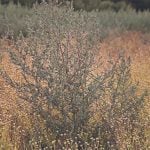Bladder stones, or obstructive urolithiasis, are a significant cause of morbidity and mortality in male ruminants, especially steers.
Uroliths form from protein and mineral components of the diet. Protein components may include cells produced during vitamin A deficiency, sutures, tissue debris, blood clots, excess protein or bacteria in the urine.
Typically, stones develop in the urinary bladder. Anatomy of the distal urinary tract of male ruminants differs significantly from that of males of other species and contributes to the development of obstructions. The S-shaped sigmoid flexure of the penis is an anatomical feature in ruminants that produces a restriction where stones lodge as they pass from the bladder to the outside. Stones often get stuck in the distal sigmoid flexure or the lower part of the “S.” The vermiform appendage of small ruminants is another common site where stones become lodged.
Read Also

The Canadian Cattle Association’s international advocacy efforts
Global ag policies affect Canadian food policy, so the Canadian Cattle Association participates in international and domestic forums
Prolonged obstruction results in:
- rupture of the urethra with a gathering of urine beneath the skin,
- or rupture of the bladder and buildup of urine in the abdomen. Both conditions are called water-belly.
Early recognition and treatment are critical. Urethral blockage can occur in bull calves but usually affects steers. Castrating bull calves slows the growth of the urethra, increasing the risk of blockage.
Signs of obstruction are primarily related to colic caused by pain: straining, pumping action of the tail and kicking at the belly. Perforation of the urethra or rupture of the bladder results in the temporary submission of signs with subsequent collection of urine beneath the skin externally or distension of the abdomen as urine collects internally.
In some herds, in some years the prevalence of urolithiasis can reach eight per cent.
Urolithiasis involves several factors. It starts when a nucleus forms. Inorganic minerals such as magnesium, calcium and phosphate are deposited onto the matrix. Additional factors include water intake, type of grass or legume consumed on pasture, predominate mineral in soil, age of steers when castrated, high concentrate (grain) rations, weaning protocol (primarily associated with water intake) and urine pH. Genetic predisposition can also play a role. Animals consuming legumes are predisposed to calcium carbonate uroliths. Silicate stones may be observed in animals grazing salicaceous plants and soils in the western U.S. and Canada. Calcium oxalate stones are associated with oxalate-containing plants.
Producers dealing with urolithiasis issues should consult their veterinarian and nutritionist. Decreased water intake during other systemic illnesses can play a role.
Treatment depends on how far the syndrome has progressed. Several techniques exist for removing the calculus. Perforation of the urethra requires amputation of the penis. Bladder rupture requires a combination of calculus removal, penile amputation and bladder repair.
A 2022 article published in Veterinary Research Communications describes a technique using pneumatic lithotripsy. Urolithiasis can be treated using various methods, but they all carry risks. Pneumatic lithotripsy is a minimally invasive method used for the pneumatic disintegration of urinary stones. Pneumatic lithotripsy provided successful results in treating urolithiasis and can be used as an alternative surgical method in cattle. Moreover, the low cost is an additional advantage to producers raising bulls for sale as herd sires.
Potential prevention methods include:
- Free-choice fresh, clean water available at all times.
- Deferred castration of bull calves until at least six months of age.
- Adjustment of calcium-phosphorus balance in feedlot rations.
- Addition of salt to rations to increase water intake.
- Early detection and treatment.
- Increasing urine volume and dilution.
- Decreasing matrix components.
- Managing mineral components.
Increasing urine volume and dilution can be achieved by providing clean, palatable, water of appropriate temperature, plus adding NaCl to the diet. High-forage diets with limited grain and pelleted feeds can increase water intake. Increasing roughage in the diet requires more water for mastication and digestion, therefore increasing urine output over that of concentrate diets. Feeding high-concentrate diets shunts water to the rumen at the time of consumption, releasing antidiuretic hormone and urine output.
Matrix components can be reduced by decreasing high-protein feeds and hays. Ensuring a solid trace mineral program with sufficient vitamin A reduces the likelihood of urinary tract metaplasia and cellular debris in the urinary bladder. Chloride salts, such as calcium chloride, sodium chloride and ammonium chloride, can attach to the matrix binding sites and prevent the formation of a nucleus.
When considering controlling mineral components, take into account the urolith type most likely to form in a particular species. For example, show animals and feeder animals are at most risk for phosphorus-based stones. Animals consuming alfalfa and other legumes are at the highest risk for calcium carbonate stones. Both form in alkaline urine. Urinary acidification can be achieved with 200 mg/kg/day of ammonium chloride orally in the short term. Animals on ammonium chloride should have their urine pH evaluated periodically five to seven hours after feeding to determine whether adequate acidification is occurring.
For animals receiving grain or pelleted feed, the Ca:P ratio of the total ration should be held at 2–2.5:1 to limit phosphorus availability for phosphatic uroliths. An increase in this ratio fosters calcium carbonate uroliths, whereas a reduction predisposes animals to phosphatic uroliths. Loose trace minerals should be provided to all classes of animals. (Merk Veterinary Manual)
Silicate and calcium oxalate urolith types are associated with specific plants on pasture, especially those that thrive in dry, high temperature environments such as much of our natural rangeland. Some producers have identified high-risk pastures and limit steers’ access to these sites, allowing females to graze.
Bottom line, urolithiasis results in significant economic loss to the feedlot industry and stands as the fifth-most prevalent cause of feedlot deaths. While obstructive urolithiasis causes symptoms in castrated males, it can occur in breeding males where treatment and surgical options for correction are limited if preservation of breeding ability becomes essential.

















